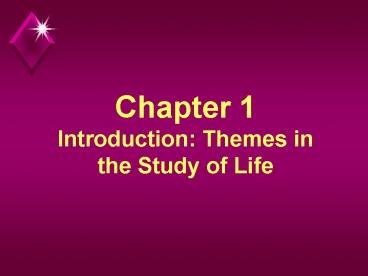Chapter 1 Introduction: Themes in the Study of Life - PowerPoint PPT Presentation
1 / 33
Title: Chapter 1 Introduction: Themes in the Study of Life
1
Chapter 1Introduction Themes in the Study of
Life
2
What are Themes?
- General principles or ideas that occur over and
over. - Themes are not a test item, but they are a
framework to organize the study of Biology.
3
AP Biology Themes
- 1. Science as a process
- 2. Evolution
- 3. Energy Transfer
- 4. Continuity and Change
4
AP Biology Themes
- 5. Relationship of Structure Function
- 6. Regulation
5
AP Biology Themes
- 7. Interdependence in Nature
- 8. Science, Technology and Society
6
Themes in the Study of Life
- 1. The living world is a hierarchy.
- 2. Cells are the basic units of structure and
function. - 3. The continuity of life is based on DNA.
7
Themes in the Study of Life
- 4. Structure and function are correlated.
- 5. Organisms are open systems.
- 6. Regulatory mechanisms maintain balance.
8
Question
- How do we know what is alive and what is not?
- What are the properties of Life?
9
1. Order
- Living things are highly organized in structure
and function.
10
- Analyzing a biological structure gives us clues
about what it does and how it works
11
- Structure and Function are related at all levels
12
2. Reproduction
- Organisms reproduce their own kind.
13
- Life on Earth uses the nucleic acid and code for
Heritable Information.
14
3. Growth Development
- Organisms increase in size and complexity.
15
- Growth - increase in size. Development -
increase in complexity. - Life - grows by internal changes.
16
4. Energy Utilization
- Organisms take in energy and transform it to do
work.
17
- Organisms are open systems, they must
continually take in energy.
18
5. Response To Environment
- Organisms respond to changes or stimuli in their
environment.
19
- The speed of the response may be fast or
slow.
20
6. Homeostasis
- Organisms maintain their internal environment
within tolerable limits. - homeo same stasis state
21
7. Evolutionary Adaptation
- Organisms change over time as they adapt to their
environment.
22
- Organisms must adapt, move, or die!
23
8. The Cell Is the basic unit
of Life
24
9. Organisms Die
25
Science is
- A process.
- A way of knowing.
26
Science is based on
- Observations
- Experiments
- Deductive Reasoning
27
Observations
- Are the keystone to Science.
- If it cant be observed, it cant be studied by
the Scientific Method. - Can be made through your senses or through the
use of tools.
28
Scientific Method
- Outlines a series of steps for answering
questions. - Obtains evidence through the use of experiments.
29
(No Transcript)
30
Scientific Method Steps
- 1. Identify the problem.
- 2. What is already known?
- 3. Formulate a hypothesis.
- 4. Conduct an experiment.
31
Scientific Method Steps
- 5. Collect data.
- 6.Compare data to hypothesis.
- 7. Conclusions and new hypothesis.
32
Summary
- We will see the themes at various times
throughout the course. - AP Biology students must be able to design an
experiment to test a hypothesis. - Why? This
is a national exam test item.
33
Homework
- Readings Chapters 1, 2, 40
- Lab Penny Lab
- Lab Report Wed. 8/28
- Chapter 40 Friday 8/30
- Chapter 2 Mon. 8/26































